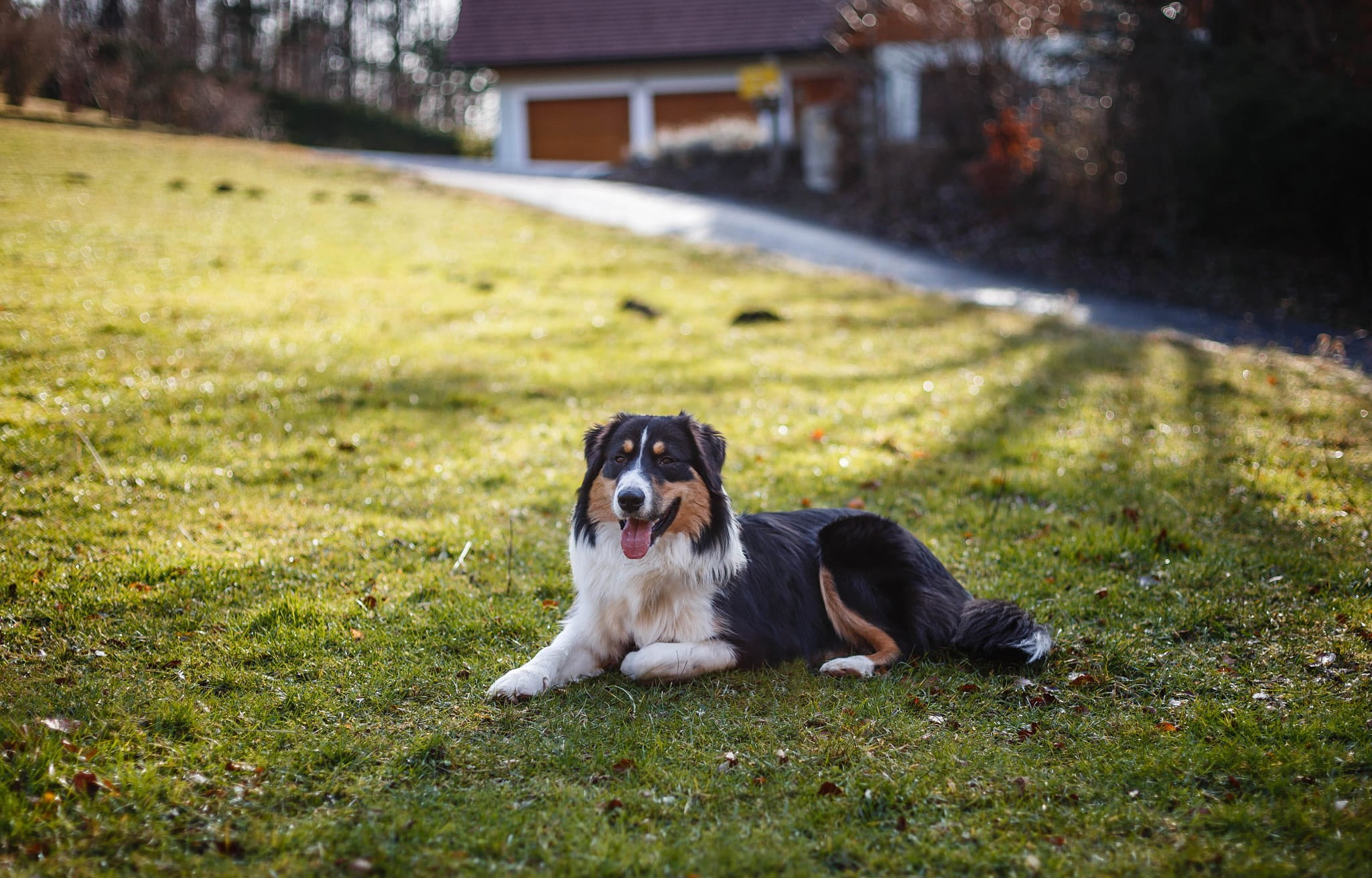How to help your dog fight seasonal allergies

When I woke up in the middle of the night to my dog sneezing, coughing, and scratching her face, I naturally became very worried.
Like any reasonable person, I began to frantically google my dog’s symptoms. The results: either my dog had a rare disease or she had allergies.
After visiting the vet, I found out that my dog, Lyra, having allergic reactions.
If you’re like me, a new dog owner, you probably didn’t know that dogs could have allergies, let alone seasonal allergies.
Well, I’m here to spread the word: dog allergies are very real; however, they are also very manageable.
In this article, I’ll be your guide to what seasonal dog allergies are (and are not), list symptoms you can look for, and help you create a comprehensive plan to combat this issue.
If you’re pressed for time, our advice is to:
1) Visit your vet.
2) Consider using natural remedies like aloe vera cream, coconut oil, an air purifier, dog-friendly grass, and omega-3 fatty acids to reduce symptoms.
3) Visit a dog dermatologist if symptoms continue or worsen.
How to tell if your dog has seasonal allergies
Just like humans, dogs can have either allergies or seasonal allergies, which are very different.
Allergies to food or materials (like rubber or metal) occur year-round and require a different treatment than seasonal ones.
Like the name suggests, seasonal allergies occur during different seasons and affect your dog differently based on the time of year.
- Spring and Summer: You will start to see reactions to spring allergens during late-February or early-March. During this season, your dog is most likely to react to various pollens from trees or grasses.
- Fall: Watch out for fall allergic reactions at the end of August and throughout September. Usually, fall allergies are caused by Ragweed.
- Winter: When it gets cold during December or January, dust mites or mold will primarily affect your dog.
While people mostly talk about “seasonal allergies” during spring time, all seasons present unique irritants and issues for both people and dogs.
If you think your dog has fleas or ticks and NOT seasonal allergies, read about treatment options here.

Playing outside is so much fun, sticks and all. Image: Lucia Buonomo
Signs and symptoms of dog allergies
Both external and internal irritation occurs when your dog suffers from seasonal allergies.
External irritation signs
- Excessive licking
- Itchy or red skin
- Itchy, watery, or red eyes
- Excessive scratching or chewing of skin (which can lead to scabbing)
- Ear redness or infection
Internal irritation signs
- Sneezing
- Coughing (or labored breathing)
- A runny nose
- Snoring
- Vomiting (severe)
- Diarrhea (severe)
While your dog may not exhibit all of the above signs at once, having a number of the listed symptoms should be cause for concern.
In the case of Lyra (my dog), I began to suspect she had a problem when she scratched and chewed at her skin, had a (mild) cough, and began sneezing on a regular basis.
Watch as Dr. Carolyn Quagliata briefly summarizes the differences between seasonal and food allergies in this short video:
What causes seasonal dog allergies?
Common environmental allergens for both humans and dogs include pollen, dust, plants, mold, and smoke.
According to the Asthma and Allergy Foundation of America, the definition of an allergic reaction is when an immune system reacts to something it perceives as a threat.
The stats behind seasonal dog allergies
According to this veterinary manual, less than 10% of all dogs are genetically predisposed to experiencing seasonal allergic reactions (atopy).
Dogs that tend to have more seasonal allergies include terriers, boxers, and retrievers.
If your dog does have this issue, you’ll begin to notice when they are around 6 months to 3 years.
Common substances that irritate dogs
- In your house: human dander, house mites, mold
- In your yard: Cotton, Dandelions, Goldenrod, Mugwort, Nettle, Thistle, Ragweed, Brome Grass, Kentucky Blue Grass, Meadow Fescue, Orchard Grass, Birch Tree, Cedar Tree, Elm Tree, Oak Tree, Walnut Tree, and Pine Tree

This dog loves playing in the sun. Image: flowcomm
How can I help my dog with seasonal allergies?
I know what you’re thinking: with so many things that dogs can be allergic to, how can I possibly help my dog with their sneezing, coughing, and itchy skin?!
Well, there’s good news.
Since a lot of dogs and humans suffer from allergies, there has been a lot of research and time dedicated to this subject.
But, remember: each dog is different and will require a unique treatment for their reaction. Some dogs may exhibit few symptoms, while others will need to see a dermatologist.
By researching, visiting your vet, and experimenting with treatment options, you’ll be able to find a solution that works for you and your furry friend.
Visit your vet
When I first noticed symptoms in my dog Lyra, I had two options: I could self-diagnose or I could take her to the vet.
I decided to take her to the vet.
Ultimately, taking your dog to the vet when they exhibit signs of an allergic reaction is the only way to rule out a more serious illness like kennel cough or a parasite.
While it’s possible to treat your dog’s allergies without a vet visit, it is not advisable as you could be diagnosing your dog’s issues incorrectly.
What antihistamines are safe for dogs?
If your dog is mildly suffering from seasonal allergies, a common “fix” for this issue is prescribing an antihistamine. Antihistamines, or drugs like Claritin or Benadryl that treat allergic rhinitis and sinusitis, are actually safe for your dog to take.
While it is safe to give dogs Claritin or Benadryl, talk to your vet about how much to give your puppy.
When I went to the vet for Lyra, a 40-pound female Labrador Retriever, the vet suggested that I give her one-half of a tablet each day for a week.
Another dog might need an entirely different amount. OR another dog may have a prescription that could interact poorly with Claritin.
The safest thing to do is consult your vet before medicating your dog.
A common solution: dog-friendly grass
If you find that your puppy only exhibits signs of spring or summer seasonal allergies, the root of their issue is most likely grass, trees, or environmental pollen.
With or without medication, having dog-friendly grass is sure to (at the very least) reduce your dog’s symptoms.
Best grass practices
- Stay away from tall grass (which tends to have more pollen) and the other grasses listed above (see “Common irritants in your yard”)
- Use dog-safe fertilizers
- Water and cut your yard frequently to reduce pollen levels
- Consider buying turf which is dog-friendly, allergen-friendly, and doesn’t yellow!
- Use Bermuda Grass Hybrids like Buffalo Grass or St. Augustine Grass that tend to have low pollen counts
If you have an apartment or condo and are considering getting patio grass, make sure that this grass is also dog-friendly. Check out our article on dog grass pads here: Which type of grass pad is right for you and your dog

“Please wipe me off after I hang out in the grass!” -Lyra, probably.
Natural remedies for seasonal dog allergies
Unfortunately, seasonal allergies are here to stay.
If you’re like me, you like to use natural remedies as solutions whenever possible. Luckily, in the case of dog allergies, there are a TON of natural remedies that you can use to drastically reduce your puppy’s symptoms.
Topical treatments
Aloe vera cream
If your dog suffers from itchy skin, consider putting aloe vera cream on your dog. Like with human skin, aloe reduces irritation and cools the skin.
Farnam makes a great aloe vera approved for use on dogs that also includes added Vitamin D, A and E. You can get this affordable ointment on Amazon.
*Note: never feed your dog aloe vera as this could lead to diarrhea or sickness.
Coconut oil
Coconut oil can be applied topically or ingested by your pup. Benefits of this oil include:
- A shinier, brighter coat
- Cooling of skin
- Less itchy, flaky skin caused by allergies
- If ingested, healthy fats and protein will help your dog be healthier all around!
The recommended dosage of coconut oil is 1 teaspoon per 10 pounds of weight. I feed my dog anywhere from 3-4 teaspoons per day of coconut oil.
While there are organic coconut oils marketed and packaged just for dogs, like Petpost organic coconut oil, the reality is there’s no discernible difference from organic coconut oil marketed for humans. A bulk option like Vita Coco organic coconut oil should last longer and be a better value.
Apple cider vinegar
For this remedy mix water and apple cider vinegar 50/50 and spray on your dog’s itchy spots to reduce irritation.
You can use apple cider vinegar that is already in your home or buy a spray like this one from Burt’s Bees that is specially formulated for dogs.
Note: do not spray this vinegar directly on an open wound as this will cause your dog pain.
Baking soda
Did you know that you can use baking soda found in your kitchen on your dog?
To relieve itchy skin due to allergies, mix 50/50 water and baking soda to create a paste. Apply to your dog’s skin, let it sit for around 20-30 minutes, then wash clean.
Tools
Air purifier
Air purifiers range in price anywhere from 50 dollars to 600 dollars and up. I recommend the LEVOIT LV-H132, a unit that won’t break the bank and is verified by the California Air Resources Board.
This machine’s HEPA filtration system will help reduce allergy symptoms in both humans and dogs by filtering pollen, dust, mold, dander, hair, and smoke out of the air.
You can read more reviews and purchase the Levoit air purifier on Amazon.
Supplements
Omega-3 fatty acids (fish oil)
Let’s get technical.
Remember how when your dog’s body comes into contact with something it perceives as a threat (like dust or pollen), it releases histamines and causes an allergic reaction?
Well, when histamines are released, inflammation and irritation increase in the body.
Omega-3 fatty acids specifically reduce inflammation thus reducing the effects of an allergic reaction. Your dog can naturally get’s Omega-3 fatty acids in salmon, however this is not always possible.
The easiest way to ensure they get enough Omega-3 is with a supplement. Vita Pet Life Omega-3 is a formula made just for your dog that comes in an easy to eat chew.
Vitamin E
This study shows that Vitamin E can actually reduce the levels of histamines in your dog’s body.
Basically, Vitamin E is nature’s antihistamine and can be given to your dog to reduce scratching, sneezing, and other symptoms caused by environmental irritants.
When to visit a dog dermatologist
If your dog’s seasonal allergies are very severe, consider seeing a dog dermatologist.
I know what you’re thinking: yes, dog dermatologists are a real thing and can help your pet in a few ways.
Note: a dog dermatologist is the most cost-restrictive method of helping your dog with seasonal allergies. While it might be necessary in some cases, I recommend trying natural remedies and a vet visit before going directly to a specialist.
Dog allergy testing
If you’re having trouble figuring out exactly what your dog is allergic to, request that your pup get an allergy test.
Like with human allergy testing, dog testing will help narrow down if your canine pal is suffering from food or environmental allergies.
Immunotherapy for dog allergies
So, immunotherapy = constant exposure to what one is allergic to until the side effects reduce in severity.
In simple terms, if your dog’s body is constantly exposed to pollen (in small to larger doses), your dog’s body will begin to understand that pollen isn’t actually that bad.
Your dog’s body will then stop producing as many histamines and your dog’s allergies will be cured! (well, for the most part).
If you start to notice that your dog has allergies around 6 months to 1 year old, you may want to consider immunotherapy. The earlier that a dog gets treatment, the more effective it is.
Immunotherapy is a great long-term treatment for seasonal dog allergies.

This doggo is happy that there’s dog-friendly grass under their paws. Image: Kevin Jensen
Reducing your dog’s allergy symptoms day-to-day
Are there things you can do right now to reduce your dog’s allergy symptoms?
The answer: yes!
Here’s a list of quick and easy tips to keeping your dog (and home) allergen-free:
- Wipe down your dog with dog wipes (or baby wipes) before bed and after walks
- Wash your dog’s face with face wipes after playing outside
- Bathe your dog frequently (around once a month)
- Keep your dog’s bed (or your bed) clean. Washing sheets and blankets frequently help keep allergens away from your dog’s skin.
Putting it all together
Now that you know way too much about allergies, it’s time to find a treatment that works for you.
In my case, Lyra’s allergies are mild and easily treatable.
I give my dog coconut oil and Vitamin E, put aloe vera cream on her coat, and wash her face and body before bed with a wipe. She’s now able to play all day in the sun without a worry!
This routine of supplements, topical treatments, and washing has worked for Lyra and I hope it will continue to work.
Keep in mind I’m not a doctor or vet and I can only tell you what’s worked for my dog. What worked for Lyra may not work for you and your canine. Experiment, find a routine that works for you, and get moving!
-Clancy Robledo
Clancy Robledo is a dog mom, content marketer, and copywriter living in sunny Austin, TX. When she’s not at home blogging, she enjoys hiking with her dog, reading, and playing board games.
Feature Image: rreichwein
